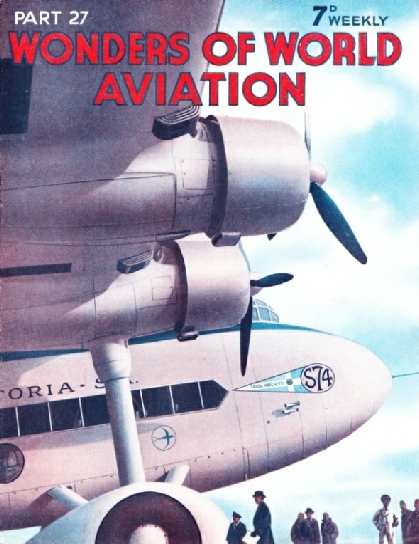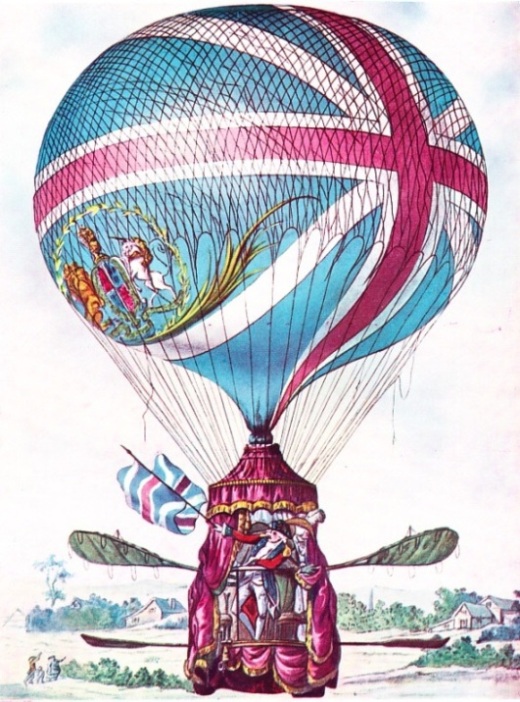
© Wonders of World Aviation 2015-


Part 27
Part 27 of Wonders of World Aviation was published on Tuesday 6th September 1938, price 7d.
This part included a colour plate showing Lunardi’s second balloon. This was one of the illustrations in the article on Britain’s First Aerial Voyages.
The Cover
Our cover picture this week shows the Savoia-Marchetti S-74 , an Italian four-engined long-distance commercial monoplane, which accommodates 20-27 passengers and has a cruising speed of 180 miles an hour at 5,250 feet. Savoia-Marchetti machines were used in massed flights led by General Balbo across the South and North Atlantic in 1930 and 1933. The S-74 is one of the latest types produced by the company.

Contents of Part 27
Great Air Experiments (Part 2)
Among the experiments dealt with in this chapter are those connected with attempts to solve the problem of landing an aeroplane within a restricted area, slow flying tests, tests with the free parachute and experiments with the free parachute.
This chapter is concluded from part 26.
Reconnaissance Aircraft
Reconnaissance aeroplanes were used also for fighting, bombing and artillery and infantry cooperation. There were two main types of reconnaissance aeroplanes, fighter-reconnaissance types attached to armies, and corps-reconnaissance types attached to army corps. Fighter-reconnaissance aeroplanes were the eyes of the H.Q. Staffs; corps-reconnaissance types were mainly used for artillery and infantry cooperation. This chapter describes the various reconnaissance machines which flew singly or in formation according to their particular duties.
This is the fourth article in the series on Aeroplanes of the Great War.
Famous German Airship Flights
Of all the controversial aspects of aviation one of the most keenly debated is the airship. Those in favour of this form of aerial transport can cite some remarkable achievements, and point to the great promise for the future which these successes imply. Whatever attitude is taken to airship development, there is no question that some of the famous airship voyages of the past have added spectacular interest to the story of aeronautics. This chapter recounts some memorable airship voyages. It recalls that the Graf Zeppelin, which was completed almost exactly ten years ago, made nearly 150 transoceanic crossings. Her flight round the world, carrying freight, mail and a complement of sixty-one, remains an outstanding event.
The Graf Zeppelin is now in honourable retirement, but the fact that she had flown more than 16,000 hours, covered 1,060,000 miles and carried 13,000 passengers.
Britain’s First Aerial Voyages
Londoners had their first sight of a balloon on November 4, 1783; but this was a small balloon incapable of carrying an aeronaut. It ascended from Cheapside and came down at Waltham Abbey, Essex, some thirteen miles away. It was not until the following year that James Tytler, a courageous Edinburgh experimenter, gained the distinction of being the first man in the United Kingdom to make an ascent. Tytler’s success was limited, but in September 1784 Vincent Lunardi ascended from the Artillery Ground at Moorfields, London, and made a voyage of some twenty-four miles to Standon, near Ware, Hertfordshire. Lunardi was in the air on this occasion for over two hours and he estimated that his balloon reached a height of four miles. After this success Lunardi made other ascents in Great Britain from Liverpool, Edinburgh, Kelso, Glasgow and Newcastle-upon-Tyne. Lunardi returned to his native Italy in 1787 and made several notable ascents there.
Lunardi’s Second Balloon
THE COLOURS OF THE NATIONAL FLAG of Great Britain were used effectively on Lunardi’s second balloon, the largest hydrogen balloon in existence in 1785. With something of the showman’s instinct, Lunardi decided that his balloon should appeal to the eye and also express a compliment to the country of his adoption. Most of the early aeronauts carried a large flag, with which they waved reassurance to spectators below. The contemporary illustrations of early balloons generally show light oars of various kinds; but experience was to prove that the attempts at propulsion by such means were fruitless and oars were discarded by the balloonists of a later date.
Aeroplane Endurance
In some ways the measure of success obtained in aviation is best shown by the increasing lengths of time that machines have been able to remain in flight. Long-range flights are now commonplace, and nothing shows more clearly the advance in every department of aeroplane design than this ability to keep flying. The extraordinary progress in endurance without refuelling is vividly set out in this account.
RAF Operations Overseas (Part 1)
An interesting aspect of a career in the RAF is recorded in this chapter dealing with the overseas operations of the Royal Air Force. The organization is an extensive one, with stations in many lands. The work, too, is varied, embracing such widely different activities as routine and long-distance flights, location of lost aeroplanes, assistance to villages cut off from ordinary communications, and survey work, including the taking of air photographs. The importance of the work done by the Royal Air Force overseas is not generally appreciated, but this chapter gives some fascinating details of its wide scope and interest. This article is concluded in part 28.
